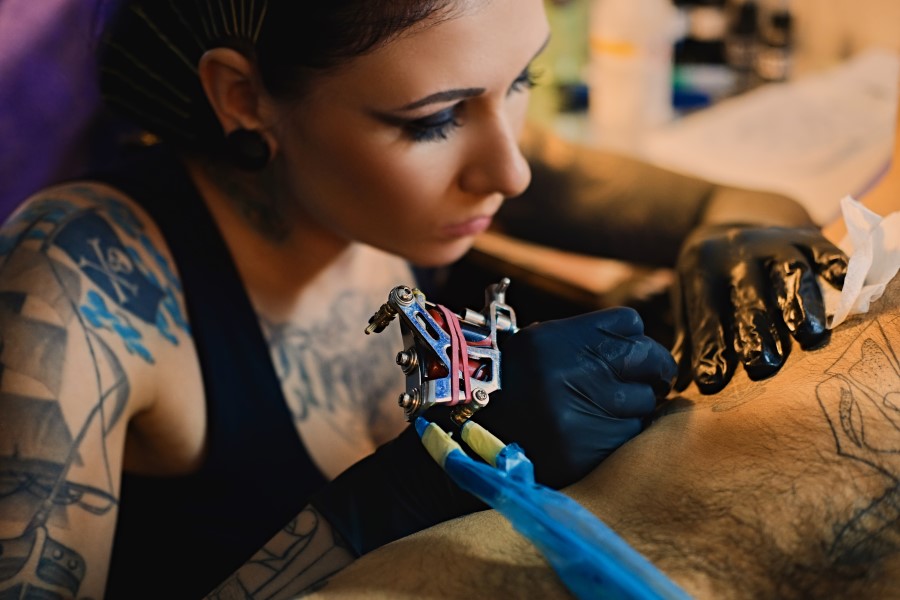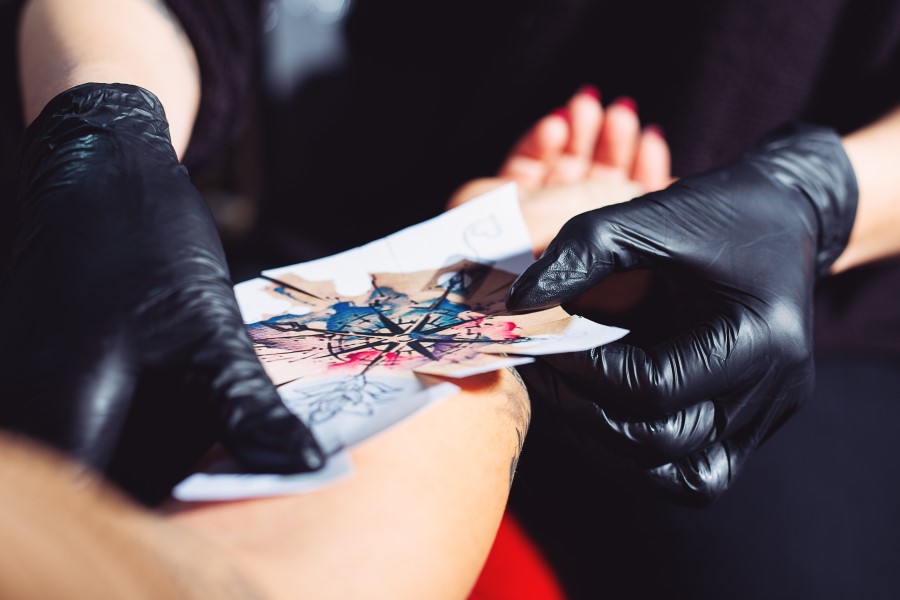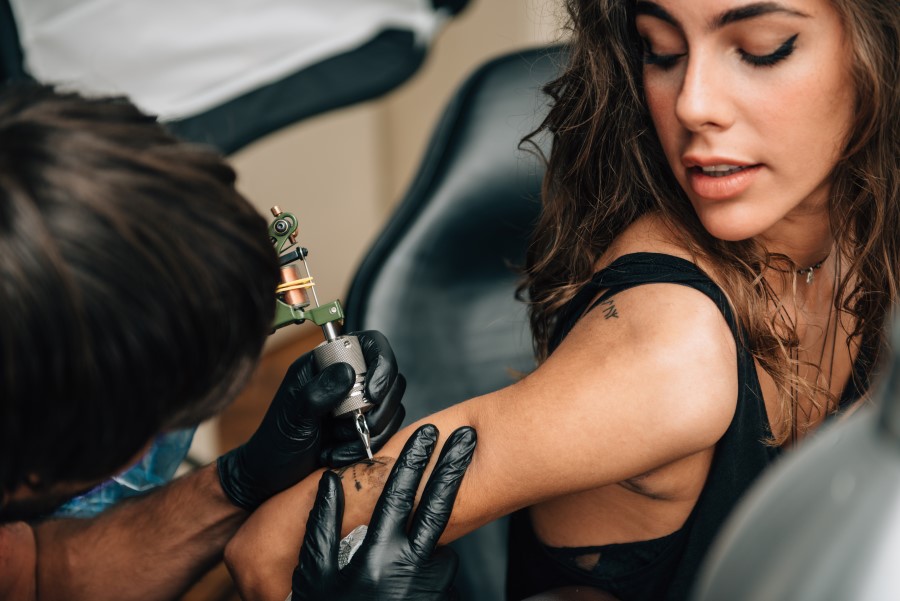Tattoos have fascinated people for centuries. Colours under the skin are associated with mysteries. But what actually happens during tattooing? What is different about tattooed skin?
We have found out what special colours for tattoos, the skin and the relationship between the two is all about. Skin researchers know exactly why colours stay on the skin and how a tattoo changes it. Obviously, they also know what care tattooed skin needs. Now we know too.

Colour plus skin equals tattoo. What happens there?
Tattooing means that a special ink is injected under the skin using needles of different thickness. Tattoo needles can have very different shapes, and colours can be red, black, blue or green, and they always go up to two millimeters deep into the skin, as deep as the dermis, which lies beneath the top layer of the skin (epidermis). The dermis can store colour pigments for a long time.
The pigments that end up in the epidermis during tattooing are lost again. The epidermis is constantly renewing itself. After around three to four weeks, these superficial colours disappear again. This is known as fading and it is a natural process. A little bit of colour always ends up in the epidermis, which is normal. It has nothing to do with the tattoo artist’s skills.
Let us be clear: tattoo artists use special needles to apply tattoo ink to the dermis, where it is retained in the long term.
Your tattoo in 3 steps
In your first consultation you will receive personalized information on your tattoo. Contact us on our email address or superchat (bottom right symbol).
Make an appointment.
Your tattoo dream will be carried out in a relaxed atmosphere.

What is tattoo ink made of?
Indigenous cultures tattoo with a mixture of ash, charcoal and fat. They insert ink under the skin with a needle made of bamboo or bone splinters. This is unthinkable in Europe, where tattoo inks are subject to strict regulations. Tattoo inks are made of solid, small pigments. These particles are so small that we cannot even recognize them. Only under high magnification does the ink reveal that it consists of liquid and solid particles. Pigment particles are responsible for giving tattoos their colours. The liquid that holds them together consists of solvents and preservatives and initially it has nothing to do your tattoo colour.
Do you suffer from allergies? Then you should pay attention to the ingredients of tattoo inks, since some of the ingredients can trigger allergic reactions. Simply ask the tattoo artist what colours they use. You should also ask for a photo of the ink ingredients. In general, inks can be traced by means of a badge code, i.e. the manufacturer’s production number.
In conclusion, we cannot say categorically what tattoo inks are made of. Their exact ingredients and ratio vary depending on their manufacturer and items.

How do tattoo colours behave after being engraved?
Your tattoo is still fresh and you have put a plaster on it. Take a close look at the patch: It is colourful, isn’t it? A part of a tattoo colour is carried out by the wound fluid after the tattoo has been applied. This is the colour you see in the patch. The crust formed on the tattooed skin can also be coloured. Please do not panic – all this is perfectly normal. Tattoo artists know it and will engrave your tattoo taking colour loss into account.
But why does the body simply transport the color out? It is supposed to stay on the skin! Tattoo inks are foreign bodies for your body, having no place in wounds. That is why your body tries to remove or break down as much ink as possible. A fairly large proportion of tattoo ink is transported into the lymphatic system during wound healing. Mainly small particles (pigments) and soluble ink parts end up there. Only the ink parts that are too large and cannot be transported remain in the dermis. This is the colour that forms your tattoo.
Excursus skin – epidermis, dermis and subcutis
Some colour ink does end up in the epidermis during tattooing. However, the epidermis renews itself every three to four weeks. This is why colours in the epidermis are quickly lost. New skin cells are constantly being created through cell division in the so-called basal cell layer. This is the boundary between the epidermis and the dermis.
Beneath the epidermis lies the dermis. This skin layer contains a system of collagens, proteoglycans and other fibers that make the skin tear-resistant and elastic. This firm network supports the dermis. Because this skin layer is so firm, it reliably stores the largest tattoo ink pigments. The dermis also has a strong blood supply and is permeated by lymphatic vessels. Furthermore, it contains immune cells, which help wounds heal after a tattoo has been applied.
The subcutis is located under the dermis. It consists primarily of fat cells and connective tissues and does not usually come into contact with tatto inks. Now the question arises: how much pigment remains in the skin after a tattoo has healed? This varies from person to person. Up to 80% of the originally applied colour can be broken down and removed. This happens because when a wound heals, a part of it is washed out via fluids and because the lymphatic system removes pigments partially. However, UV rays also destroy some colour pigments. Once healing is completed, tattoos do not reach their final colours yet.

Colour perception and tattoos
Why do tattoo colours look different in the bottle than on tattooed skin? It depends on the light. If the light falls directly on colours, they shine very brilliantly and sometimes appear rather weak. However, on tattooed skin the light is filtered through the skin and it penetrates into the skin only partially. This is because your skin is pigmented and filters the light with the aim to protect your body from harmful UV radiation, among other things.
Tattoo pigments also filter the light. If the light is absorbed across the entire spectral range, tattoos look black. If pigments only filter a part of the visible light, a colour impression is created. This can be blue, but also any other colour, from yellow to green and red. Tattoo care products ensure that colour brilliance is maintained for a long time.
Tattooed skin is altered skin
There are still very few scientific studies on how tattooed skin changes. However, we know for sure that tattooed skin is different from “virgin” skin. Reports are certainly available. Tattooed people claim greater sensitivity to light and sunshine. Tattooed skin is more prone to itching and, therefore, more easily irritated.
You may have heard that tattooed skin can no longer sweat. This is nonsense. Sweat glands, like pigments, are located in the dermis. Pigments do not block sweat glands. Large, dark tattoos heat up a lot in the sun. Accordingly, you should protect your tattooed skin with skin care products and UV protection (SPF 50+).
Temporary and permanent tattoos
Airbrush and henna tattoos are not permanent and their colours sit on the skin. Since epidermis cells are renewed every three to four weeks, temporary tattoos disappear very quickly. This happens particularly quickly on your hands: Due to frequent washing, drying and contact with all sorts of things, the outer skin layer renews itself singularly quickly here.
The difference between temporary and permanent tattoos lies in the ink used and its location. In tne case of permanent tattoos, colours are injected into the dermis, i.e. the dermis under the epidermis. The dermis does not renew itself, so colour pigments remain there.

